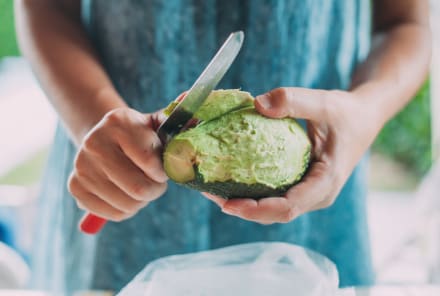Advertisement
What To Eat (& Avoid) For A Healthy Gut, From A Microbiome Expert


"You can change your gut microbiome within about a week just by altering your diet," award-winning microbiome expert, author of Food for Life: The New Science of Eating Well, and co-founder of ZOE, Tim Spector, M.D., shares on this episode of the mindbodygreen podcast. There are trillions of bacteria residing in your gut, which are constantly evolving based on your inputs. Feed them what they crave, and the community will thrive—quickly.
It raises the question: What do your gut microbes need, exactly, in order to flourish? Below, Spector shares his top tips (plus what to avoid for optimal gut health):
30 different plants per week
First, Spector recommends eating a greater variety of plants—at least 30 different plants per week, to be specific. The recommendation comes from a study by The American Gut Project, which found that participants who consumed more than 30 varieties of plants per week had the healthiest gut microbiomes.
If you have a diverse amount of plants in your diet, that leads to microbial diversity in your gut—and different kinds of gut microbes produce unique beneficial chemicals for your body. "There are over 50,000 identified chemicals in food, and each of those can be a target for a microbe that only lives off that particular chemical," Spector explains. "That's why the greater the range of chemicals you eat, the more you make sure you've got every possible species of good microbes inside you."
Now, eating 30 plants per week may sound like an insurmountable challenge, but try to think outside the box. "That includes not only fruits and vegetables but nuts, seeds, herbs, and spices, so it's actually not as hard as you think to get the 30 in," says Spector. (Psst: Coffee is technically a plant too!)
"Adding just a mixed bag of nuts and seeds to your breakfast cereal or yogurt can give you 10 plants," he adds. "Once you start thinking about plants differently and adding herbs and spices to your meals, it's really not that hard." One of our editors even tried the 30-plant challenge for herself—see here for how it went.
Especially colorful plants
It sounds similar to tip No. 1, but in addition to eating more plants, Spector says to eat a variety of colors too.
"Plants that are full of color—bright reds, purples, blues, yellows—all have different defense chemicals in them, phytonutrients that we call polyphenols," he shares. "These defense chemicals are useful in plants to keep them alive and are like rocket fuel for our gut microbes." They have anti-inflammatory, neuroprotective, and cardioprotective activities that support everything from longevity to cardiovascular and cognitive function.
You may hear about certain superstar polyphenols—like resveratrol, lycopene, beta-carotene, and so on—but Spector says eating a variety of plant colors will inherently check all those boxes. "It's [about] embracing the diversity, all the colors, trying to eat new things every week, and really getting a greater breadth of food rather than limiting it to one or two superfoods," he notes.
Fermented foods
Like many other gut experts, Spector is a fan of fermented foods. "Have fermented foods, several portions, every day," he says. "And go for a variety of fermented foods because then you get the diversity of microbes in them."
He specifically shouts out the "four K's," kimchi, kefir, kombucha, and 'kraut, as well as miso and yogurt. "Most yogurts are generally healthy, except the ones that are highly processed, have artificial sweeteners, all the fat removed, or fake bits of fruit in them," he explains. He recommends plain, full-fat yogurt if you do choose to go the dairy route.
To avoid: ultra-processed foods
We'll end on what to avoid: ultra-processed food. "These are the hyper-palatable foods that make us overeat, that are highly refined and don't fill us up," explains Spector. They can also wreak havoc on your gut microbes, he says. Research1 even shows that consuming ultra-processed foods is associated with gut microbes linked to inflammatory gastrointestinal diseases.
To be clear, Spector isn't talking about minimally processed items. It's unrealistic to completely avoid any foods that have been altered in some way—olive oil and honey, for example, are both technically processed. Some packaged options can be part of a healthy diet, but it's the ultra-processed foods laden with artificial colors, flavors, and unhealthy fats that can pose a problem, especially if you consume them more than whole or minimally processed foods.
The takeaway
"The food choices you make every day are the most important things you can do for your health," Spector adds. These four above are just a few you can choose for the sake of your gut microbiome, and it doesn't take much time to reap the benefits. Follow Spector's recs (more of them in the full episode) for at least a week, and you may start to see some gut health improvements.
We hope you enjoy this episode! And don't forget to subscribe to our podcast on iTunes, Google Podcasts, Spotify, Amazon Music, or YouTube!
Watch Next
Enjoy some of our favorite clips from classes
Enjoy some of our favorite clips from classes
What Is Meditation?
Mindfulness/Spirituality | Light Watkins
Box Breathing
Mindfulness/Spirituality | Gwen Dittmar
What Breathwork Can Address
Mindfulness/Spirituality | Gwen Dittmar
The 8 Limbs of Yoga - What is Asana?
Yoga | Caley Alyssa
Two Standing Postures to Open Up Tight Hips
Yoga | Caley Alyssa
How Plants Can Optimize Athletic Performance
Nutrition | Rich Roll
What to Eat Before a Workout
Nutrition | Rich Roll
How Ayurveda Helps Us Navigate Modern Life
Nutrition | Sahara Rose
Messages About Love & Relationships
Love & Relationships | Esther Perel
Love Languages
Love & Relationships | Esther Perel
What Is Meditation?
Box Breathing
What Breathwork Can Address
The 8 Limbs of Yoga - What is Asana?
Two Standing Postures to Open Up Tight Hips
How Plants Can Optimize Athletic Performance
What to Eat Before a Workout
How Ayurveda Helps Us Navigate Modern Life
Messages About Love & Relationships
Love Languages
Advertisement

This Underconsumed Nutrient Helps Fight Gum Inflammation, Study Shows
Molly Knudsen, M.S., RDN

Research Shows Cognitive Longevity Depends On These 3 Critical Vitamins
Molly Knudsen, M.S., RDN

This Underconsumed Nutrient Helps Fight Gum Inflammation, Study Shows
Molly Knudsen, M.S., RDN

This Underconsumed Nutrient Helps Fight Gum Inflammation, Study Shows
Molly Knudsen, M.S., RDN

Research Shows Cognitive Longevity Depends On These 3 Critical Vitamins
Molly Knudsen, M.S., RDN

This Underconsumed Nutrient Helps Fight Gum Inflammation, Study Shows
Molly Knudsen, M.S., RDN











